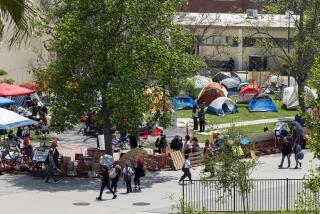Noted Scientist Still Unsure of Move to UCI
- Share via
Noted medical researcher Jerrold Petrofsky, who last week moved to Lake Forest, insisted Saturday that he has not yet decided whether to move his projects to UC Irvine.
Petrofsky, 38, said that although he bought the house near El Toro, “there has been no decision made” on whether he will leave Wright State University in Dayton, Ohio, where he developed an electronic system to help paraplegics walk.
“I am at this house right now. I own it. Whether I keep it and stay will be determined by the negotiations with UCI and Wright State. There is no outcome yet,” Petrofsky said.
Petrofsky said he planned to return to Dayton today for further discussions with Wright State officials.
Petrofsky developed the Functional Electronic Stimulation System, which uses computerized electrical impulses to stimulate muscles and help paraplegics walk. He has been the subject of two reports on CBS’s “60 Minutes,” and his life and research were depicted in the movie, “First Steps.”
Volunteer Professor
Petrofsky, who has one year remaining on his three-year contract with Wright State, has begun a temporary stint as a volunteer clinical professor at UC Irvine while the negotiations continue.
A Wright State spokesman said Friday that the university still has not received word from Petrofsky about his plans. But Petrofsky said Saturday that he has been waiting to hear from Wright State.
“I thought I would hear from them this past week, but I didn’t,” he said.
Meanwhile, Cy Laughter, a former Wright State University trustee who has raised money for Petrofsky’s research, said he believed that the professor is trying to play the universities against each other, which “is not good . . . because it detracts from the efforts to help the kids who want to learn to walk.”
Laughter said Petrofsky’s programs would continue without him, but that it was doubtful that UC Irvine could persuade federal agencies to transfer Petrofsky’s research funding there, as UC Irvine hopes to do.
Petrofsky said Saturday that whether he can transfer those grants to UC Irvine would “be a great consideration” in his final decision.
As part of the negotiations with Petrofsky, UC Irvine has applied for a $2-million grant from NASA. The grant would finance a 2 1/2-year study on isometric exercise in zero-gravity during a space shuttle flight that has not been scheduled. The UC Irvine application jeopardizes Wright State University’s chance to obtain the money.
VA Grant at Stake
Also at issue is a $774,000 grant from the Veterans Administration for efforts to make Petrofsky’s computer-controlled walking system commercially available.
“I would be surprised if he got the VA money after leaving Dayton,” Laughter said. “Our congressmen worked very hard to get it and they’re not likely to sit back and watch the money go elsewhere.”
Laughter said Rep. Tony P. Hall (D-Ohio) was particularly concerned about the possibility of losing the grant, which was approved in congressional hearings held earlier this year.
But Petrofsky said helping the handicapped is important, not where the money is used.
“I would hope that Mr. Hall realizes that what is important is the plight of disabled people, not his political career. I think he’s man enough to do that,” he said.
Alan G. Harper, director of the Veterans Hospital Medical Center in Dayton, said Dr. Tanil Akuthota, the hospital’s acting chief of rehabilitation medicine, is a partner in the VA-funded project and could continue the work without Petrofsky.
“If he leaves Wright State, we’re going to try to keep the project money here. The grant that has been approved is basically for producing a marketable product. The money is supposed to (become available) beginning Oct. 1,” he said.
Could Divert Funds
But Petrofsky said that it was “up to the funding agencies to decide what is best for disabled persons” and it was “likely” he could get the funds diverted to UC Irvine if he decides to move here.
One reason he bought the house, he said, is that he already spends much of his time in California. He currently is doing work with other researchers at UC Berkeley and USC, he said. In two weeks, Petrofsky said, he and another USC professor will present a paper at a sports medicine conference in Israel.
Petrofsky added that he may even buy property in Houston, because he spends at least two months there each year working on a project with the National Aeronautics and Space Administration.
Laughter speculated that Petrofsky “probably wanted to move out there and may have approached UC Irvine instead of the other way around. He was out there for several months recently, at the Pritikin weight-loss clinic, where he lost about a hundred pounds.”
Laughter said he and other Petrofsky boosters in the Dayton community do not feel “betrayed” by their friend because, “It is a competitive world out there. . . . If he wants to go out there, then he should go, so that they (researchers remaining in Dayton) can get organized. The only important thing to us is to help the people (patients) to walk again.”
Built Around Petrofsky
The $9-million National Center for Rehabilitation Engineering at Wright State was “built totally around Dr. Petrofsky and his work,” Laughter said, but others there are capable of carrying on that work.
Wright State, he said, was a campus known for its work with the handicapped before Petrofsky arrived.
“They had tunnels for handicapped students to go through from building to building, and special class rooms and other things. He was interested in this school because of that,” Laughter said.
Times staff writer Roxana Kopetman contributed to this story.






